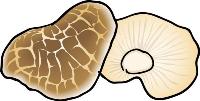Nutrition
HOW DOES THIS FUNGUS ACQUIRE NUTRIENTS?
G. applanatum is not photosynthetic like plants; it is heterotrophic, however, like animals. But fungi have a special vegetative growth form that animals do NOT have; fungi, including Ganoderma applanatum, have hyphae. When feeding off alive/dead trees, these hyphae grow to increase surface area. Why would fungus want to increase surface area? By increasing surface area, the fungus is able to break down more plant material by digesting then ingesting; this is done by releasing exoenzymes. Ganoderma applanatum breaks down the complex polymer lignin within the tree into inorganic compounds, such as carbon, nitrogen, etc. By doing this, these elements are easier to absorb. Ganoderma applanatum absorbs nutrients in order to get food; in fungi, food is stored as glycogen.
DOES GANODERMA APPLANATUM OVERCOME ANY PROBLEMS IN ORDER TO SURVIVE?
Ganoderma applanatum does not really overcome any problems in order to survive. This fungus grows where there are nutrients; if there are not any nutrients in a section of a tree, the fungus grows around to find more nutrients. It will increase surface area while trying to find nutrients. Also, when fungi see light, that triggers them to release spores. So, if a fungus is eating through a tree and has reached the other side, the fungus will eventually grow through and detect light. Once Ganoderma applanatum and other species of fungus detect light, they disperse spores, which grow into new fruiting bodies. Then these new fungal spores will find a different location to grow and flourish.
WHAT IS THIS FUNGUS’S HOST?
Ganoderma applanatum is a basidomycete; basidiomycetes are important decomposers of wood and other plant material. So what trees act as hosts to Ganoderma applanatum? This fungus is found on almost every deciduous hardwood tree, oak, magnolia, and elm to name a few.
NEXT PAGE = LIFE HISTORY & REPRODUCTION
 Artist's Conk (Ganoderma applanatum)
Artist's Conk (Ganoderma applanatum)